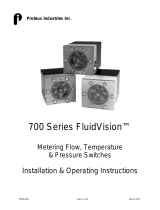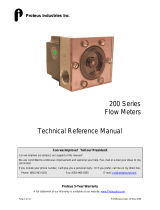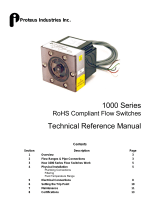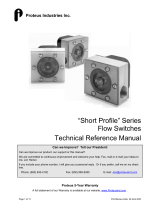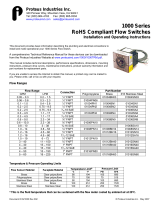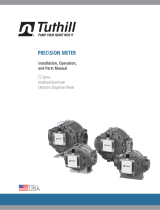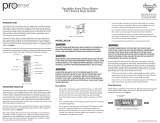Page is loading ...

800 Series
Metering Flow
Switches
TECHNICAL REFERENCE MANUAL

2
Table of Contents
Section Page
1. Introduction 2
2. Features and functions 2
3. How the flow sensor works 7
4. Specifications and performance 8
5. Product certifications 9
6. Installation 9
Mechanical 9
Electrical 13
7. Selecting Trip Points 14
8. Measuring Flow Rate 16
9. Digital Displays 16
10. Cleaning and Maintenance 18
11. Calibration & Recalibration 20

3
Section 1 Introduction
800 Series Metering Flow Switches have been created to provide a more effective monitoring and control
capability for applications in which liquid flow rates from 0.05 to 50 GPM (0.2 to 190 LPM) must be
monitored and controlled over extended temperature and pressure ranges.
Many capabilities required for extreme operating conditions have been incorporated in the basic product,
allowing the size-reduced metering flow switches to be used in situations in which specialized products
were previously required.
The 800 Series Metering Flow Switches have been developed from Proteus’ experience in satisfying the
needs of thousands of demanding users in widely diverse applications since 1978.
Section 2 Features and Functions
• Flow ranges from 0.05 to 50 GPM, 0.2 to 190 LPM.
Eight flow ranges are provided in the 800 Series in brass, polypropylene or stainless steel. NPT and
SAE connections are available.
Proteus 500 Series Metering Flow Switches formed in stainless steel provide similar measurement
and control capabilities for flow rates up to 4.5 GPM. The 500 Series devices occupy less space than
800 Series units, and as standard are capable of operating to 250 psi (690 kPa).
• Calibrated 0-5VDC output
800 Series switching flow meters are calibrated to provide a 5 VDC output at the maximum flow rate
of each version. Actual flow rate in your circuit can be determined by attaching a voltmeter. An
optional scaleable digital voltmeter can be calibrated to provide a direct local display of flow rate.
• Compact design
Depth depends on connection size and type
Figure 1: Outline of 800 Series

4
The depth of the flow sensor bodies changes with connection size. 0816XXX bodies are taller and wider
than the example shown above.
Detailed drawings for any version of can be obtained by calling (650) 964-4163 and asking for Technical
Support or by e-mail at tech@proteusind.com.
• Compact design is easily retrofittable
❖ Mechanical and electrical interfaces are identical to those of hundreds of thousands of Proteus
24VDC flow switches and flow meters already in use.
❖ The 800 Series is completely retrofittable in place of existing Proteus flow switches.
❖ The distance between the 800 Series pipe or fitting connections is identical to those of previous
Proteus flow sensors.
• Stainless Steel faceplate extends operating range
❖ Adding stainless steel or brass faceplates permits brass and stainless steel versions of the 800
Series to be operated over the range of -40 to 140 ºC and to 250 psi (1720 kPa).
❖ A Viton® O-ring provides the liquid seal. Other materials are optionally available for enhanced
chemical compatibility with specialized coolants.
• Trip point is user selectable.
Figure 2: Rear view of 800 Series Metering Flow Switch
16-position
switch
Tri-color LED
Fine adjust
potentiometer

5
Trip points are selected by adjusting a 16-position switch as shown in Table 1.
This feature provides the ability to change trip point settings predictably, accurately and reproducibly
without the use of complex instrumentation.
See Section 7 for instructions on selecting trip points.
• Optional potentiometer provides fine tuning capability
If your trip point must be set with finer control than is provided by the 16-position switch a
potentiometer provides the adjustment you need. This potentiometer can be adjusted from 7 o’clock
to 5 o’clock positions. Refer to Section 7 for instructions on selecting trip points.
Note
Elbows and other devices that induce swirling motion in the flowing liquid that are installed
within a distance of approximately 10 x the ID of the inlet port reduce the linear velocity
of liquid through the flow sensor.
When such devices are present the actual flow rate through the flow sensor may be HIGHER
than is suggested in Table 1.
Model
Number
Switch Position
0
1
2
3
4
5
6
7
8
9
A
B
C
D
E
F
0804BN03
0804PN03
0804SN03
0.01
0.03
0.05
0.06
0.08
0.10
0.12
0.14
0.16
0.17
0.19
0.21
0.23
0.25
0.26
0.28
0804BN2
0804PN2
0804SN2
0806SA2
0.18
0.29
0.41
0.52
0.63
0.75
0.86
0.98
1.09
1.20
1.32
1.43
1.54
1.66
1.77
1.89
0804BN4
0804PN4
0804SN4
0806SA4
0.36
0.62
0.87
1.13
1.39
1.65
1.91
2.17
2.43
2.69
2.95
3.21
3.46
3.72
3.98
4.24
0806BN10
0806PN10
0806SN10
0808SA10
0.89
1.46
2.03
2.60
3.17
3.74
4.31
4.88
5.45
6.02
6.58
7.15
7.22
8.29
8.86
9.43
0808BN15
0808PN15
0808SN15
1.6
2.5
3.3
4.1
5.0
5.8
6.6
7.5
8.3
9.1
10.0
10.9
11.7
12.5
13.3
14.2
0812BN19
0812PN19
0812SN19
0812SA19
1.6
2.7
3.8
4.8
5.9
7.0
8.1
9.2
10.3
11.4
12.5
13.5
14.6
15.7
16.8
17.9
0812SA25
1.8
3.2
4.7
6.1
7.6
9.0
10.5
12.0
13.4
14.9
16.3
17.8
19.2
20.7
22.1
23.6
0816BN50
0816PN50
0816SN50
0816SA50
3.6
6.5
9.4
12.3
15.2
18.1
21.0
23.9
26.8
29.7
32.6
35.5
38.4
41.3
44.2
47.1
Table 1: Flow Rate in GPM at selected Switch Positions with straight connection to inlet
port and fine adjustment potentiometer in the 12 o’clock position.

6
• LED provides instant status information.
Like a traffic signal, the green, amber and red lights indicate flow status so that problems are easily
detected. Green, amber and red lights provide instant indication of the status the flow switch and the
flow rate. An additional LED monitor can be remotely mounted at your control panel.
❖ If the three-color LED is ON you know that 24VDC power is being delivered to the flow
switch and the flow switch is functional.
❖ The color of the LED changes depending on the ratio of the actual flow rate to the Trip Point
LED
Color
Flow Rate Status
Example Trip Point 10 GPM
Relay State
NO contact
NC contact
Green
Greater than 1.15 x flow
rate at selected trip point
Actual Flow > 11.5 GPM
Closed
Open
Amber
Between 1x and 1.15 x flow
rate at selected trip point
10 < Actual Flow < 11.5 GPM
Closed
Open
Red
Less than flow rate at
selected trip point
Actual Flow < 10 GPM
Open
Closed
• Multiple outputs provide control flexibility
Electrical interfacing of the 800 Series units is effected through an 8-pin connector that provides a
range of control options while delivering 24VDC power. See Section 6, Installation for connection
details.
Connector Position
800
Function
Notes
1
Power input
24 VDC ± 10%
2
Ground connection for power
& output signals
Should be connected to a valid system ground
3
Output Voltage
Calibrated to provide 5 VDC at the maximum flow rate
4
Normally Closed relay
contact
Connects to NC contact of relay.
5
Common relay contact
Connects to Common contact of relay
6
Normally Open relay contact
Connects to NO contact of relay
7
Red LED anode
Connections for a remote tri-color LED indicator.
Common cathode of tri-color LED should be connected
to ground
8
Green LED anode

7
Section 3 How the flow sensor works
The rotor spins when liquid flows through the
meter.
Magnets in the rotor switch a Hall-effect sensor
mounted in the meter body.
The resulting pulse train is converted by the
electronics to a voltage that is proportional
to the linear velocity at which the liquid flows
through the meter.
Switching
The measured output voltage is continuously compared to a user-selected trip point voltage. When the
measured voltage is above the trip point, the built-in relay remains in its active state. If the measured
voltage falls below the trip point due to reduced or stopped flow, the relay contacts open, signaling an
alarm condition to your control system.
Metering
Accuracy of calibration to ± 2% of full scale is established against a flow standard with a certified
accuracy of ± 0.5%. Calibration is traceable to a NIST reference. Linearity is better than ± 0.5%.
Magnets
Rotor
Hall effect
sensor

8
Section 4 Specifications and performance
The most current information on the performance capability of these sensors is accessible at the Proteus
web site at www.proteusind.com.
Flow Ranges
Connection
Part Numbers
GPM
LPM
Brass
Polypropylene
Stainless Steel
0.05 - 0.3
0.2 – 1.2
¼” NPT
0804BN03
0804PN03
0804SN03
0.15 – 2.0
0.6 – 7.6
¼” NPT
0804BN2
0804PN2
0804SN2
0.3 – 4.5
1.2 –17
¼” NPT
0804BN4
0804PN4
0804SN4
0.3 – 4.5
1.2 – 17
9/16 -18 SAE
0804SA4
0.8 – 10
3 – 38
3/8”NPT
0806BN10
0806PN10
0806SN10
0.8 – 10
3 – 38
¾ -16 SAE
0806SA10
1 – 15
3.8 – 56
½” NPT
0808BN15
0808PN15
0808SN15
1.3 – 19
5 – 72
¾” NPT
0812BN19
0812PN19
0812SN19
1.5 – 25
6 – 95
11/16 -12 SAE
0816N25
3 – 50
11 - 190
1” NPT
0816BN50
0816PN50
0816SN50
3 – 50
11 – 190
15/16 -12 SAE
0816SN26
Liquid operating Limits
Temperature
- 40 to 100oC (-40 to 212 oF) with standard polysulfone faceplate.
-40 to 140oC -40 to 284oF
Electronics must be thermally isolated from flow sensor at temperatures
above 85°C and below dew point.
Pressure
1720 kPa 250 psi
Kinematic Viscosity
To 120 centistokes
Wetted Materials
Flow Sensor Body
304 Stainless Steel
Faceplate
316 Stainless Steel
Sealing O-ring
Viton ® (Other materials are available.)
Rotor
Carbon fiber-filled Nylon
Rotor Shaft
316 Stainless Steel (Other materials are available.)
Meter Performance
Voltage Output
0– 5 VDC for the maximum rated flow for each sensor type
Accuracy
± 2 % of full scale
Improved accuracy and linearity performance over smaller flow ranges
can be achieved by specialized NIST-traceable calibration procedures.
Linearity
Better than ± 1% from 10 to 100% of nominal full scale
Reproducibility
Better than ± 0.5% above 10% of nominal full scale
Switch Performance
Trip Point Selection
16 position changes trip points in steps of 6% of nominal full scale with fine
adjustment between steps.
Hysteresis / Dead Band
< 5% of actual flow rate
Switch type
Relay Closure
Relay rating
SPDT 48 VDC, 1.0 A
Electrical
Power Requirements
24 VDC, 40 mA
Electrical Connection
Plug type EDZ1550/8 with screw fastening of 8 conductors up to #16 gauge.
Remote Electronics
Optional mounting locates electronics up to 30 ft from flow sensor. Required for
operation above 85°C.
Flow Certification
Standard products are provided with certificates of compliance. Specialized
calibration certificates are optionally available.
Digital Display
Optional panel mounted displays flow rate GPM or LPM on 3½ digits.

9
Section 5 Product certifications
800 Series Metering Flow Switches are CE marked for compliance with the EU Directive 89/336/EEC for
Electromagnetic Compatibility.
800 Series Metering Flow Switches have been Safety Certified by RWTUV as a low voltage, Class III
device.
Section 6 Installation
CAUTION!
It is generally undesirable to mount any plumbing connections directly over
electronic controls or instruments.
WARNING!
If the 800 Series flow sensor is mounted in a vertical pipeline, any leakage from the topmost
connection could enter the unit and cause permanent damage to the electronics.
For applications where there is condensation, moisture, dampness, or dripping water,
please contact Proteus Technical Support for other product recommendations.
Pipe or tubing mounting
If rigid piping or tubing is used, the 800 Series metering flow switch may be supported by direct
connection to the pipe or tubing.
Panel mounting
To mount the sensor behind a panel, two of the faceplate securing screws will need to be replaced with
longer screws to compensate for the thickness of the panel. Ensure that the screws are not so long that
they will touch the bottom of the tapped hole, or rip through the back of a plastic body if over-tightened.
Evenly space up to six holes for 8-32
screws on a 2.5” circle. Using the two holes
on the horizontal plane is usually sufficient
to support smaller flow sensors and all
plastic sensors. If you wish the rotor to be
visible, cut a 1¾” diameter hole with the
same center.
1. Remove screws holding the faceplate to
the sensor body.
2. Place the sensor behind the panel and
insert the longer screws you have
selected.
3. Secure the screws in the body with a
torque of ~ 10 in-lb. (Finger tight with a
flat-blade screwdriver.).
Figure 3: Layout for panel mounting

10
Note
Dimensioned drawings illustrating the 800 Series Metering Flow Switches are available as
PDF files on our web site at www.proteusind.com.
Plumbing Connections
Note
Before connecting a sensor into your fluid line, verify that the normal flow rates expected in that line
are within the operating range of the sensor.
Extended use above the rated maximum flow rate of the sensor will reduce its useable life.
CAUTION
Do NOT use anaerobic pipe sealants such as LOCTITE brand sealants or SWAK with
the 800 Series metering flow switches fitted with a clear polysulfone
faceplate.
The aggressive chemical nature of these materials can cause cracking of the
polysulfone faceplate.
Use Teflon (PTFE) tape or PTFE-based liquid sealants to provide leak-tight and
lubricated junctions at all connection points.
Real-Tuff and Hercules are two of many suitable brands of PTFE-based sealants.
Note
It is recommended that connections to the stainless steel flow sensor be made with stainless steel or
materials of similarly chemical inertness to minimize potential corrosion damage.
Note
The flow response of the sensor, and thus its calibration may be dependent on the internal diameter
(ID) of an incoming pipe, or the ID of a tube connection.
If the ID of your pipe or tube fitting where it connects to the inlet port is LESS than the value shown in
Table 2, calibration values may be invalid.
Appropriate calibration procedures can be applied to allow the 800 Series flow sensor to be used with
pipes and connections with ID’s smaller than those shown in Table 2. Contact Proteus for assistance.

11
Model #
Flow Range
GPM
Flow Range
LPM
Orifice ID
inches
Orifice ID
mm
080XN03
0.05 – 0.3
0.2 – 1.2
0.063
0804XN2
0804SA2
0.1 – 2.0
0.6 – 7.5
0.188
4.8
0804XN4
0804SA4
0.3 – 4.5
1.2 – 17.0
0.270
6.9
0806XN10
0.8 – 10
3 – 38
0.370
9.4
0806SA10
0.8 – 10
3 – 38
0.400
10.1
0808XN15
1 – 15
3.8 - 56
0.460
11.7
0812XN19
0812SA19
1.3 – 19
5 – 72
0.610
15.5
0812SA25
1.5 – 25
6 - 95
0.610
15.5
0816XN50
0816SA50
3 – 50
11 – 190
0.870
22.1
Table 2: Minimum ID of pipe or connection for calibrations to be valid.
Note
The flow response of 800 Series sensors and thus their calibration may be dependent on the form of the
device attached to the inlet connection and other closely located up-stream devices.
Elbows, T-pieces, valves and filters located immediately up-stream from the flow sensor can introduce
swirling motion to the liquid flow. The swirling motion reduces the linear velocity of the flow stream.
We recommend that a straight run of pipe of more than 10 x pipe ID be used between the flow sensor and
any up-stream devices to minimize these effects.
Appropriate calibration procedures must be used to provide an accurate flow measurement with elbows
or T-pieces that must be attached directly to the inlet connection.
The 800 Series sensor is typically unaffected by the form or proximity of devices on its downstream side.
Sensor Orientation
For the best results, 800 Series sensors should be mounted with the faceplate in the vertical plane.
Mounting the device with the flow connections uppermost can help eliminate entrained air from your
system.
Flow Direction
The 800 Series Metering Flow Switch is not sensitive to flow direction. Flow can be introduced to the
sensor from either side.
NPT pipe thread connections
Pipe threads seal by making metal-to-metal contact between male and female components.
Consequently, they are particularly prone to the damaging effects of galling, which occurs when two
surfaces move against each other under pressure. When installing pipe threads it is essential to use a
high quality lubricating and sealing material.

12
• Use Teflon tape or a PTFE-based liquid sealant to provide lubrication for the junction and a leak-tight
connection at both input and output connections. Real-Tuff and Hercules are two of many suitable
brands of PTFE-based sealants.
• Do not over-tighten the connection. Refer to instructions for installation of the mating fittings for
information on torque requirements.
• Leak testing of all connections in your flow circuit is recommended. Pressurizing the system with air
and external testing with a dilute soap solution can help identify leaking connections.
SAE straight thread connections
With these connectors, an O-ring makes the seal while the threads hold the connecting assembly in
place. Straight thread connections should receive a small amount of high-pressure lubricant before
installation to prevent galling.
Non-adjustable fittings
1. Bring the non-adjustable fitting into firm
contact with the face of the port, using a
wrench.
2. Check to be certain that the O-ring fits
easily into the non-threaded receiving
area of the port, and is not pinched.
Adjustable fittings
1. Ensure that the locknut is positioned so
the back-up washer is in contact with
the beginning of the threads farthest
from the end of the fitting.
2. Screw the fitting into the port until the
back-up washer contacts the sealing
face.
3. Check to be certain that the O-ring fits
easily into the non-threaded receiving
area of the port, and is not pinched or
damaged.
4. Unscrew the fitting a maximum of one
turn to position it in the desired direction.
5. Tighten the locknut firmly against the
back-up washer so the fitting assembly
is held securely in place.
Filtering
Your circulating fluid may contain particles. While not essential to the operation of the flow sensor, it is
good practice to filter your fluid. A 100-micron filter is often used to remove rust and other particles from
the fluid. This can increase the lifetime of pumps and other fluid system components as well as reducing
wear in the sensor.

13
Fluid Temperature Range & Remote Mounting Electronics
If fluid temperatures will be outside the range of 0 - 85°C, the electronics package must be mounted
remotely from the sensor.
Remote mounting requires customized changes to the sensors.
Please contact Proteus Applications Support for additional information.
Electrical Connections
Note
Only personnel familiar with the electrical circuit and control functions of the system in which
the sensor is to be included should perform installation of this product.
Electrical inputs and outputs are provided at a single eight-pin socket. An 8-pin connector providing
screw fastening of up to #16 gauge conductors is provided with the 800 Series metering flow switch.
Replacement 8-pin connectors can be obtained from Proteus, P/N 440157 or from electrical distributors,
On-Shore Technology P/N EDZ1550/8, or Digi-Key P/N ED1966-ND.
See Section 9 for installation of Digital Display units.

14
Section 7 Selecting Trip Points
Adjustment of trip points in steps of 6% of the rated full scale is made with a 16-step switch and a single turn
potentiometer accessed through the cover of the electronics.
Tool Required: A fine flat screwdriver
1. Identify the Part Number of the 800 Series metering flow switch being adjusted. This is noted on the
product label.
2. Select the Trip Point Flow chart that applies to your metering flow switch.
3. Look across the row to identify the flow rate that is immediately higher than your required trip point.
4. Look up the column with the selected trip point flow rate to identify the required switch position.
Figure 4: Trip point adjustment controls for 800 Series
5. Check that the indicator of the fine adjustment potentiometer is pointed towards the 12 o’clock
position. If necessary, use the screwdriver to turn the fine adjustment potentiometer so that the
indicator is pointed towards the 12 o’clock position
6. Peel away the protective label covering the 16-step switch and the fine adjustment potentiometer.
7. Check that the indicator of the fine adjustment potentiometer is pointed towards
8. With the screwdriver, turn the 16-step switch so that its indicating arrow points towards the selected
position switch position.
Turning the switch CLOCKWISE selects a HIGHER trip point.
Turning the switch ANTI-CLOCKWISE selects a LOWER trip point.
9. Adjust the position of the fine potentiometer as required.
When the potentiometer is turned clockwise the trip point is INCREASED.
When the potentiometer is turned fully counter-clockwise the trip point is DECREASED.
10. Replace the protective label. Write the selected trip point on the label.
The orientation of the 16-position
switch is indicated by small arrow.
The orientation of the fine
adjustment potentiometer is
indicated by two indents.

15
Section 8 Measuring Flow Rate
The voltage output by the 800 Series metering flow switches allows the flow rate of the liquid passing
through the device to be estimated.
While the flow response curves of the 800 Series metering flow switches are extremely linear, they do
NOT pass through zero, requiring the use of a linear regression formula or calibration graphs to derive the
actual flow rate from the measured output voltage.
Calibration curves and derived look-up tables obtained from measurement of multiple sensors are shown
below.
The equations under each graph may be used with PLC or other control devices to obtain a more
accurate measure of flow.
Section 9 Digital Displays
Digital display units
Digital panel display meters are available to provide a direct local display of flow rate in selected
engineering units. Each unit has a 3½ digit LCD display with 0.6-inch high digits and a DIP switch-
selectable decimal point. The digital display unit requires 4 mA at 9 to 28VDC.
Flow Range – GPM
Part Number
Flow Range - LPM
Part Number
0.05 – 0.3
0G804D03
0.2 – 1.2
0L804D1
0.2 – 2.0
0G804D2
0.6 – 7.6
0L804D7
0.3 – 4.5
0G804D4
1.2 – 17
0L804D17
0.8 – 10
0G806D10
3 – 38
0L806D38
1.0 – 15
0G808D15
4 – 56
0L808D56
1.3 – 19
0G812D19
5 – 72
0L812D72
3 – 50
0G816D50
11 – 190
0L816D190
Table 3: Part Numbers and flow ranges for Digital Displays for the 800 Series
Note
Switches and potentiometers have been set to fit the range of your devices.
Changing these settings may invalidate the calibration!
Connecting the Digital Display Unit

16
The electrical connections are made via screw-clamp terminals located on the back of the Digital Display
unit.
Figure 6: Rear view of Digital Display Unit
Note
When wiring the unit check the wiring label on the back of the flow meter to ensure that
you connect to the proper terminals.
Connection instructions:
1. Strip connecting wire leaving approximately ¼” bare wire exposed. Stranded wire should be tinned
with solder.
2. Insert the wire into the screw-clamp terminal and tighten the wire until the wire is clamped tightly.
Each terminal will accept up to two #14 AWG wires.
24 V-DC Power
Supply
Signal +
Ground or
Common
Power
9 to 28V-DC
+24VDC
C
Ground or -ve
Figure 7: Wiring connections for Digital Display

17
Section 10 Cleaning and Maintenance
Maintenance of the 800 Series Metering flow switch is normally limited to cleaning the chamber in which
the rotor spins and an annual recalibration.
Cleaning the 800 Series flow sensor
The frequency of cleaning will vary with the type and cleanliness of the liquid being run through the flow
meter. In most cases, annual cleaning immediately prior to recalibration is sufficient.
Tools required:
Wrenches to disconnect the flow meter from your flow circuit.
A flat screw driver.
Soft cleaning cloth
Alcohol, water or a dilute detergent solution.
Cleaning the 800 Series Flow Sensor
1. Turn OFF the liquid flow in your flow circuit
and remove the 800 Series sensor from
your system. Place the sensor on a clean
surface.
2. Remove the 6 screws securing the
faceplate.
3. Remove the faceplate from the flow meter.

18
Cleaning the 800 Series Flow Sensor
4. Remove the rotor and stainless steel shaft
from the flow cavity.
Remove the O-ring from the faceplate
5. Using a soft cloth dampened with water, alcohol or a light detergent solution, clean debris and dirt
from the rotor, the stainless steel shaft, the inside surfaces of faceplate and the surfaces of the flow
cavity
6. Inspect the bearing surface of the rotor.
If the bearing surface is worn or not round, replace the rotor.
Inspect the stainless steel shaft.
If the shaft shows signs of scoring or other wear, replace the shaft or the whole faceplate assembly.
7. Inspect the O-ring to ensure that it is not
brittle, cracked or otherwise damaged.
If necessary replace with a #132 O-ring of a
material compatible with the liquid being
passed through the flow meter.
Position the O-ring on the inner rim of the
faceplate.
8. Place the rotor in the flow cavity.
Position the shaft (or the faceplate) to locate
the shaft in the rotor.

19
Cleaning the 800 Series Flow Sensor
9. Position the faceplate so that the holes
in the faceplate are aligned with the screw
holes in the front of the flow sensor body.
Replace the 6 securing screws.
Tighten the screws to a torque of 40 in-lbs
(hand tighten with a normal screwdriver).
11. Install the flow meter in your system.
Turn on liquid flow and check for leaks at the faceplate and connecting ports.
Tighten all connections as required to eliminate leaks.
Section 11 Calibration & Recalibration
Note
800 Series sensors are calibrated at Proteus with water at temperatures ranging
from 22 to 28C.
Changes in fluid type can alter the calibrated response of the sensor.
Large changes in liquid temperature can alter the calibrated response of the sensor.
Please contact Proteus Technical Support if a specialized calibration is needed.
Note
As described in the Plumbing Connections section on page 10, the response of the 800
Series flow sensor may be affected by the way in which the sensor is connected to your
system.
The 800 Series metering flow switch has been calibrated during manufacture to provide
an output of 5.0 VDC for the full scale limit of the flow meter, with straight pipe
connections.
Customized calibration procedures can be performed to change the flow rate corresponding
to 5.0 VDC, for fluids other than water and with connections with internal diameters less than
those used in the flow sensors. (See Table 2, page 10).
Recalibration
The calibration of the 800 metering flow switch should be checked at 12-month intervals, and recalibrated
as required. Re-calibration may be accomplished in either of two ways:

20
Calibration by Proteus
To obtain a price quotation and a Return Material Authorization number for recalibration of your flow
meter, contact s[email protected] or call (650) 964-4163.
When received at Proteus, your flow meter will:
1. Have its output measured and recorded in the as-received state.
2. The rotor, stainless steel shaft and sealing O-ring will be replaced.
3. The flow cavity will be cleaned and the device reassembled.
4. The unit will be recalibrated to its original specification against reference standards whose
calibrations are statistically controlled against NIST-traceable standards.
5. A new calibration certificate will be issued.
6. A new calibration label will be attached to the flow meter.
Direct calibration against NIST-traceable standards is optionally available.
Calibration by another laboratory
The calibrating laboratory will issue certificates and labels identifying the calibration status of your
metering flow switch.
Please advise your selected calibration laboratory to contact Proteus for calibration instructions.
Nylon, Real-Tuff and Hercules are trademarks of their respective holders
800 Series electronics are sensitive to Electro Static Discharge. There is normally no need to open the electronics case, but if it is
opened, proper ESD precautions should be taken.
Information in this document was correct at the time of printing; however, specifications are subject to alteration as Proteus
Industries’ continuous improvement processes establish new capabilities.
© Proteus Industries Inc.
800TRM Rev 003 02/2019
/

